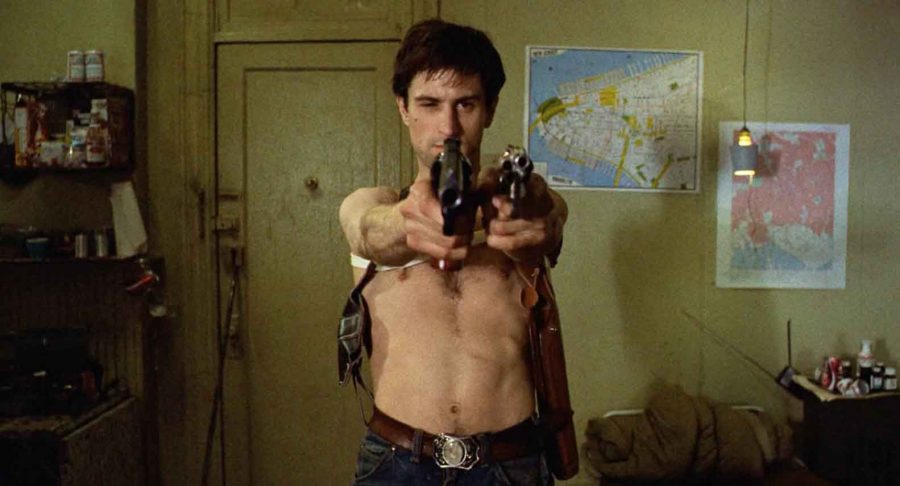Taxi Driver: “There is no escape.” -Travis Bickle
March 23, 2017
In a city full of bright lights, a man drives in darkness. Solitude is the last thing you would expect to find in New York City. This is the story of a man who could not take it anymore. A man who refuses to watch the scum fill the streets as people just walk on by. Travis Bickle monotonously lurks through the grimy streets of New York City in his cab to pick up the scum he despises. It’s a cycle that builds a dark anger and rage inside him which forms his psychosis. With every passenger who slides into his taxi, his anger swells and develops a broad insanity that deepens his loneliness.
In many ways Travis is just like the rest of us. Loneliness can drive people to extremes. Isolation from life itself can be maddening. You’re alive, but not living. The absence of being is no different from death. What do you have to lose when you have never lived? Nothing. This is deeply apart of Travis, and it’s what drives him to “really go out and do something.” Distraught with the sights he sees on a daily basis, he strives to find a purpose. However, Travis is trapped in loneliness and he only has himself to confide in.
As the film begins we see Travis become the Taxi Driver. Opting for nights, “anytime, anywhere” he repeats. His demeanor and his silence portray him as somebody who has a rooted hatred. As time goes on Travis’s mind succumbs to more and more of his own insanity. His quest for a purpose festers into something psychotic and he begins to commit himself to a more sinister ideology.
Travis has reached commitment. He makes a few calls and meeting is set up. Travis meets a gun salesman in a hotel room. The salesman, dressed in a tailored brown suit displays his pistols on the hotel bed. The meeting ends and Travis buys 4 pistols and returns home to begin his training.
He begins to weaponize himself. The time for action is dawning on his horizon and he is preparing for nightfall. He prepares his weapons along with training his body. Travis’s purpose is becoming more clear.
As he drives his taxi around the day he stumbles upon a young girl (Played by Jodie Foster) he’s seen before. He gets out a finds that she’s a prostitute. Here he discovers her name is Iris. Devoid of a purpose or a plan of action, Travis volunteers himself to rescue Iris from the hell he sees her in.
Travis’s plan isn’t revealed until he acts on it. Assassinate Palantine. The camera pans the crowd watching Palantine give his speech and Travis is revealed towards the back of the crowd. He has shaved his hair into a mohawk, he has become a psycho. Looking on, clapping for Palantine, he watches and waits until he gets off stage. Travis rushes while reaching for his .44 but is discovered too soon and runs for it, narrowly escaping. His plan has failed but the rage, the unspent purpose remains. Night falls and Travis returns to the whorehouse where he saw Iris. Insanity pours onto the screen. Travis kills everyone in his way in order to rescue Iris inside. The ticking time bomb has exploded. It is over. Travis Bickle has succeeded.
Nobody does it better than Scorsese, De Niro, and Schrader. That last name might sound unfamiliar and it’s because he stays off the screen. Paul Schrader, the writer of Taxi Driver is very much Travis himself. While writing the script for Scorsese, the writer had been through some traumatic times. Newly divorced from his wife, he spiraled into loneliness. Finishing the script in under a month, one could speculate the emotions of those events transformed into the emotions of Taxi Driver. Loneliness, Isolation and an inspiration from the diaries of Arthur Bremer all went into the melting pot that Schrader forged into Taxi Driver. Scorsese said once while talking about Taxi Driver that, “the precision with which Schrader was able to create the character, the feeling, the thoughts, and psychological insight of this character Travis Bickle, I just identified with him. We understood how he felt.” Scorsese confessed that he knew, “Schrader had hit a truth with the audience.” “There was something that touched a chord with me. I felt I could express that through the visual interpretation of the film, and utilizing the key instrument. The Voice. The Actor. Robert De Niro.”
Taxi Driver is a manifesto that’s resonates with American society. As Americans we hold a certain value for heroes who rescue a person from a terrible world. We grant a license to kill because we see it as a just cause. In the classic story of The Searchers, a Western starring John Wayne, the same idea is played upon. A man’s niece is captured by Comanches and he doesn’t care how many he needs to kill in order to get her back. It’s that same insanity Travis has, but because we sympathize with Travis we stick with him for awhile.
The scene where Travis looks for advice is such a key scene. It’s the point in the film where we establish a larger sympathy for Travis, but we also see he’s staring to go insane. He tries to look for answers from “Wizard”, another taxi driver but with no avail. After admitting that “things got me down” he pauses and spills out “I just want to go out and really… really, really do something.” “Taxi life you mean?” Wizard says. It’s here that you realize Travis is no longer talking to Wizard, but just himself. The quandaries of his mind are too immense for any normal man to solve. This scene is also where Travis finds his purpose, he knows it’s evil but it is justice. He is the only one who will act when no one else will. When everyone else is just another one of them. There lies that just cause again. How far are we as an audience, willing to let him take it though? There is a charisma to Travis we hold, but when does that sympathy fade? Where do we as an audience draw the line and say we can no longer stand behind Travis’s cause?
Another to keep in mind is that Travis is a racist. You can feel the tension as he stares at the black men across the dinner. He drops an Alka-Seltzer tab into his water and he spaces out watching the water bubble. Travis is just that, bubbling over, tired of the things he sees, and tired of seeing the people who commit those crimes. Not even five minutes later Travis walks out with Wizard to talk and a group of black men walk by. Travis stares at the leader as he walks by and the leader stares back. The camera tracks each character and slowly zooms in and create a visible tension between the two. Later on Travis is in a convenience store when a black man walks in and begins to rob the cashier at gunpoint. Travis sneaks behind him and shoots him. There is hardly any hesitation. Travis stands over him as the man lays lifeless on ground, gun still in hand Travis pins his hand to ground with his foot. The cashier says, “he’ll handle it” and Travis leaves. The ending shootout was originally intended for Travis’ victims to be black, but Scorsese along with Schrader decided it would make the movie into a racist kind of film. The film is not intended to be racist, it’s only Travis’ character that is suppose to have that racist undertone.
Travis’ obsession with guns and his superfluous use of violence is another way we as Americans identify with him. That classic .44 Magnum, which spans almost the entire length of Travis’ midsection has America written all over it. Travis’ final scene in which he kills indiscriminately is something we all find an entertaining connection to. We as Americans crave that violent entertainment, and Travis’ rampage is under our category.
It’s that classic mirror scene that is the key to it all though. “You talking to me?” he repeats to the mirror. The camera shifts from watching Travis talk to himself, to Travis talking to us. “You talking to me?” he asks again as he looks straight into the camera. The things we see in Travis, the guns, the violence, the racism are a reflection of who we are as a society. Travis is American Society.
As Travis’ rampage comes to a close and he recuperates there is something people often miss. As he drives Betsy home he drives off back into the night. Driving back into darkness he quickly checks his mirror as if he saw something behind him. The dream begins again. Travis’ insanity has fueled a hatred he has deep inside him. The ticking time bomb has reset. It all begins again. Travis is not finished with the streets of New York.


















